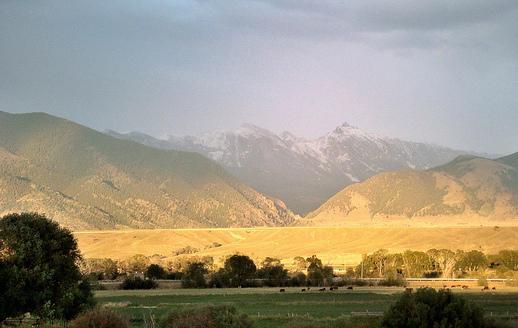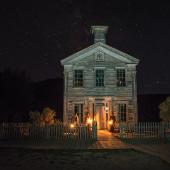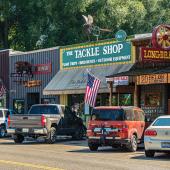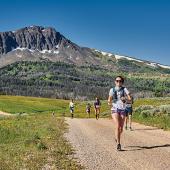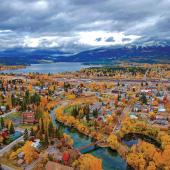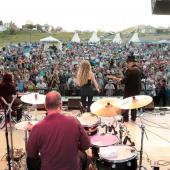All About Ennis
At the base of the majestic Madison Range, along a prime fly fishing section of the Madison River, lies a close-knit western community that’s interconnected the old-fashioned way—before modems. Here, drivers’ nods of acknowledgment function as the traffic lights on Main Street. The downtown storefronts also seem from another era, with old-West names like Yesterday’s Soda Fountain, the Silver Dollar Saloon, and the Rusty Cowboy Gallery. And it soon becomes evident that the residents in this town wear many hats: the bank vice president organizes the Fourth of July parade; the local hairdresser serves as secretary for the annual rodeo; an antique dealer doubles as a valley historian. It’s this community solidarity that enables Ennis, with its population of 1,000, to organize crowd-gathering events like the fly fishing and music festivals. And it was this same enterprising spirit that earned Ennis a spot on the map, just 60 miles southwest of Bozeman.
History
The Madison Valley was originally the hunting territory of Shoshone, Flathead, and Bannack tribes. When Lewis and Clark trekked through the region, they stopped short of present-day Ennis, exploring as far as the Bear Trap Canyon. It wasn’t until 1863, when Irish-born freighter William Ennis took 100 oxen, mules, and saddle horses across the Tobacco Root divide that white men saw the splendor—and lucrative potential—of the valley. William cut the lush hay that grew along the river and sold it in Virginia City for $125 per ton. He then hung around long enough to build a one-room cabin and claim the area as a homestead.
If the town’s founders ever fished, the history records make little mention of it—but they did own elk as pets. We also know that William, Sr. built the Ennis Post Office and became its postmaster in 1881. He owned 2,000 acres and enjoyed considerable prosperity until his life was brutally cut short in 1898, when he was shot dead by his former friend, Martin Peel. No one knows Peel’s motives, but some speculate he was mentally unstable and, perhaps, resentful: Ennis had beaten Peel in a school board election, and was subsequently chosen over him to lead a vigilante posse to track down horse thieves. A transcript of the murder trial can be viewed at the local courthouse.
The town of Ennis is now primarily cattle country and, as it’s better known, the epicenter of fishing on the Madison.
Fishing
World-renowned fishing is easily Ennis’ main draw. Downtown, the welcoming party is a bronze statue of a fisherman battling his catch through a rippled current made of stones. It’s a place where the trout outnumber the residents eleven to one. To fly fishing pilgrims, it’s a Mecca for their own brand of worship on some of the river’s best blue-ribbon fishing spots. Several national outdoor magazines cite Ennis as boasting more trophy trout rivers, streams, lakes, and ponds than any other fishing destination worldwide. And all within a short drive.
Savvy fishers anticipate the salmon fly hatch at the end of June, or the ant hatch in late August. Glen Gallentine of The Tackle Shop recommends testing your cast at the Lion’s Bridge or the Upper Madison, where rainbows and browns are abundant. Graylings can be caught on the upper Big Hole River or the smaller, more intimate Ruby River. The Ennis area is also replete with lakes for drift boats: Cliff, Wade, Hebgen, Quake, and Ennis lakes are all easily accessible for floaters who want a change in scenery from the Lower Madison. Most outfitters, like The Tackle Shop or the Madison River Fishing Company, post or divulge information about the fishing conditions and bait preferences. Stop by the shops or check online at www.mrfc.com.
Other Activities
Though the area’s fishing gets all the glory, Ennis provides access to a wide range of outdoor adventure. Nearby Lee Metcalf Wilderness Area and the Gallatin, Yellowstone, and Beaverhead-Deerlodge national forests contain excellent summer romping grounds for hikers and campers. The Beaverhead-Deerlodge National Forest alone spans more than three million acres, making it the largest national forest in Montana. And the Bear Trap Canyon Wilderness, the nation’s first BLM wilderness, offers excellent hiking at the northern end. A trailhead starts three miles up a gravel road off Highway 84, where a bridge crosses the Madison River approximately eight miles northeast of Norris. For more information, call the Forest Service in Ennis at 682-4253.
Avid paddlers can slice through nine miles of churning whitewater in the Bear Trap Canyon just south of Ennis Lake, where ruddy canyon walls rise an abrupt 6,500 feet to the tops of the Spanish Peaks. Just remember to check the bulletin boards at the launch site for the current flow. A few miles downstream you can join the more laid-back floaters putting in with tubes, friends, and a cooler.
Climbing options near Ennis include Neat Rock and Revenue Flats. Neat Rock has climbing for all levels and is less than a half-hour’s drive from Norris along the Madison. In the Tobacco Root mountains, about 10 miles west of Norris, Revenue Flats offers a series of granite domes spread across a broad bench of sagebrush and scattered pine. Comprised of both BLM and private land, the Flats has climbs ranging from 5.7 to 5.12. Many climbs are bolted with top anchors, but a few require traditional protection, says Chris Naumann of Barrel Mountaineering in Bozeman. You can drive to the Flats, park right next to a climb, and enjoy an excellent view of the Spanish Peaks—which also offer excellent alpine climbing, if you’re an experienced mountaineer and in excellent shape. For more information or guided trips contact Mike Cooperstein of Montana Alpine Guides (586-8430) or visit his website at www.adventuremontana.com.

